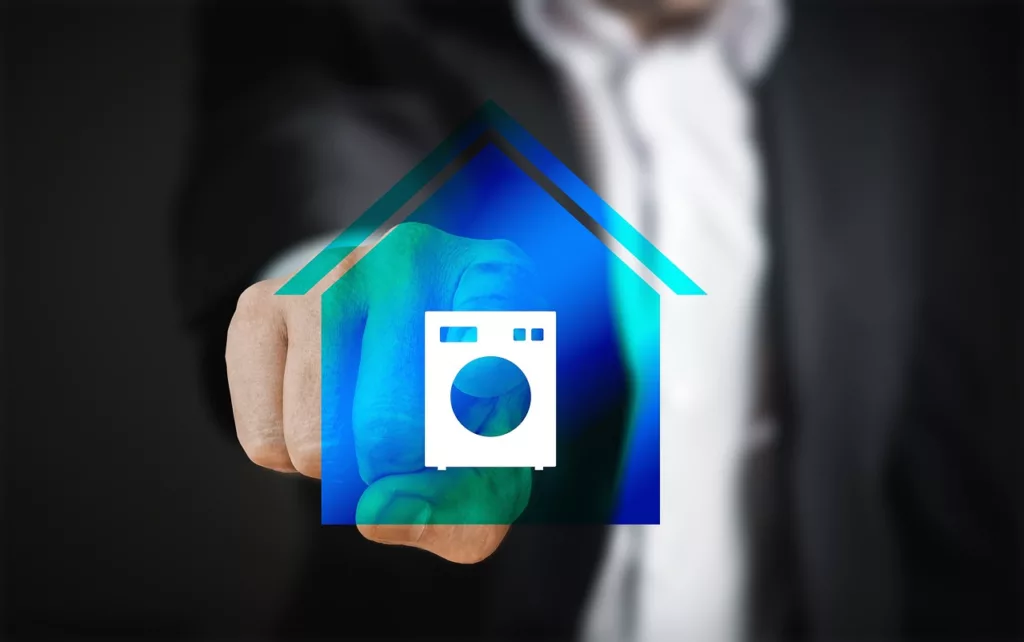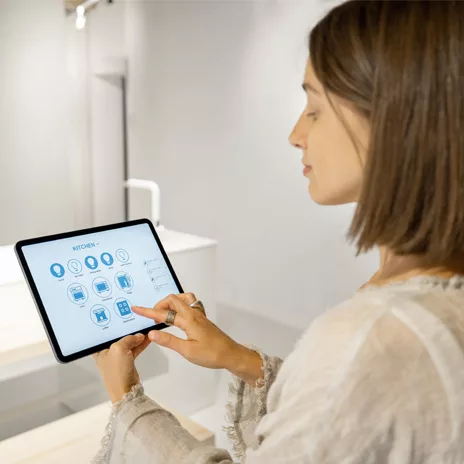Hi, I’m Roddy Rodstein, co-founder of Heidi’s House. We specialize in smart home design and installations. As I talk with clients and folks new to smart homes, it becomes apparent that the massive amount of smart home products, services, and options is causing choice overload and disappointment. To overcome these smart home challenges, I’m pleased to introduce you to The Heidi’s House 2023 Smart Home Design and Installation Guide. Our goal with the Heidi’s House 2023 Smart Home Design and Installation Guide is to save you time and headache by walking you through the decision-making process for a whole-home design and installation, resulting in a document that can be used by you or a professional to design, quote, and install your dream smart home. Embrace the future and enjoy your smart home journey! Happy home automation!
Introduction
Smart homes have transitioned from concept to reality, with approximately 63.43 million US homes using smart home devices. A smart home leverages technology to create a more efficient, convenient, and comfortable living environment. It allows residents to interact with their homes in ways once considered science fiction, making everyday tasks more manageable and enjoyable while enhancing overall quality of life.
As we approach the close of 2023, the smart home market has grown exponentially, offering a massive portfolio of options to cater to every homeowner’s needs, desires, and Budget. Whether you’re a tech-savvy enthusiast or a newcomer intrigued by the potential of a smart home, The Heidi’s House 2023 Smart Home Design and Installation Guide will walk you through the process of creating your smart home design and installation plan for your dream smart home.
Before moving on, please grab a pen and paper, and let’s start your smart home design and installation document. We aim to have you complete a smart home design document to be used as a road map for your smart home project.
Smart Home Key Components and Features
First, we will review the key components, features, and aspects that define a smart home. For example, consider which features you want in your dream smart home…
- Connected Devices: Smart homes are equipped with a wide range of devices, including but not limited to Wi-Fi, smart speakers, lighting systems, shades, thermostats, security cameras, door locks, appliances, and entertainment systems. These devices are designed to connect to the internet or a central hub, allowing management anytime, anywhere.
- Automation: Automation is a core feature of smart homes. Homeowners can create routines or scenarios that trigger specific actions based on various criteria, such as time of day, sensor inputs (e.g., motion or temperature), or voice commands. For example, lights can automatically turn on when motion is detected, or the thermostat can adjust itself based on the preferred temperature schedule.
- Voice Control: Contemporary smart homes incorporate voice assistants like Amazon Alexa, Google Assistant, or Apple Siri. These voice-controlled systems enable residents to control smart devices, act as inter-coms, ask questions, set reminders, and receive information using natural language commands.
- Remote Access: With the help of smartphone apps, homeowners can remotely monitor and control their smart home devices anytime, anywhere. This includes adjusting thermostat settings, checking security camera feeds, locking doors, and turning off lights left on accidentally.
- Energy Efficiency: Smart homes feature energy-efficient devices and systems. For instance, smart thermostats can learn residents’ temperature preferences and optimize heating and cooling schedules to reduce energy consumption. Smart Lighting can automatically dim or turn off lights when rooms are unoccupied. Likewise, Smart Shades can automatically open and close based on the time of day, providing light and shade accordingly. Smart Water Systems reduce the risk of water damage by providing leak detection and automated water shutoff protection, water usage statistics, and water conservation analytics.
- Security and Surveillance: Smart home security systems include features like video doorbells, motion sensors, and alarms. Residents can receive alerts and view live camera feeds on their devices, enhancing home security and peace of mind. A smart security system can be self-monitored or professionally monitored.
- Entertainment: Smart home entertainment systems often include streaming devices, smart TVs, and whole-house audio systems. Residents can access and control their entertainment content through voice commands or smartphone apps.
- Health and Wellness: Some smart homes incorporate health and wellness devices like fitness trackers, smart scales, and health monitoring equipment. These devices can help individuals track their well-being and provide data to healthcare professionals if needed.
After reading the above list, please take a moment, grab a pen and paper, and create your smart home design document.
First, add the heading, Budget, at the top of the page, and enter your smart home project’s Budget. Every project discussion starts with a budget. The Smart Device List section of the document will help calculate the equipment costs and manage your budget.
Next, add the heading, Smart Home Ecosystem, at the top of the page; please leave the line under the first Smart Home Ecosystem heading empty; you’ll fill this in soon.
Next, create the Smart Home Features heading and prioritize the devices and features that align with your needs and lifestyle.
Next, create the Automation heading and add the desired automations.
Example smart home design document…
Budget
Between $8000 and $12,000.
Smart Home Ecosystem
Smart Home Features
1) Connected Devices with Voice Control and Remote Access
a) Smart speakers in each bedroom to play music, set/manage alarms, and for announcements and communication, i.e., intercom and phone.
b) Smart lighting for each room in the house so we can manage all the light anytime, anywhere.
c) Smart shades for the front and rear of my home that open and close automatically with the time of day.
d) Smart thermostat to manage our home’s climate.
e) Smart Security System with a doorbell camera, backyard camera, front and rear door locks, door/window sensors for the exterior doors, and street-level windows.
f) Smart refrigerator with a touch screen and a camera to see what’s in the refrigerator while I’m grocery shopping.
g) Smart entertainment systems for the master bedroom and the living room.
h) Water leak detection and automatic shutoff system with water conservation analytics.
2) Automation
a) Arm the security system at bedtime and unarm it when we wake up.
b) Arm the security system if no one is home, and unarm the system when someone returns.
c) Show the doorbell camera on specific devices when the doorbell is rung.
d) Manage our home’s climate.
e) Open and close smart shades in the front and rear of my home based on the time of day.
f) Close the smart shades in the living room and turn on accent lights and the TV for movies and shows.
Selecting Your Smart Home Ecosystem
Before we dive into smart home devices and their categories, it’s essential to understand the prominent players in this ever-evolving landscape to be able to select your home’ ecosystem.
Your technology preferences may influence choosing a smart home ecosystem. If you are an Apple home with iPhones, iPads, Siri, AppleTV, etc., it aligns you with Apple’s ecosystem. You align with Amazon’s ecosystem if you have a Ring security system, Android devices, Alexa, and an amazon.com customer. You align with Google’s ecosystem if you have Nest and Android devices and use Google Assistant. Nowadays, devices are cross-compatible and available in one or more ecosystems. Conversely, the smart home platforms from Amazon, Apple, and Google do not interoperate by design, forcing you to decide on a single ecosystem.
Smart Home ecosystem options:
- Amazon: Amazon’s market-leading Alexa ecosystem revolves around its voice assistant, Alexa. Amazon’s Echo lineup is by far and away the most extensive voice assistant portfolio, including smart speakers, displays, sensors, and hubs that will fit in every room of your home. As of 2020, the Alexa ecosystem included over 100,000 smart home devices, according to data from Statista.
- Google: Google’s smart home ecosystem is anchored by Google Assistant, accompanied by Google’s Nest family of devices encompassing smart speakers, displays, thermostats, security cameras, and more. As of 2020, Google’s ecosystem included 50,000 smart home devices, according to data from Statista.
- Apple: Apple loyalists will rely on Siri as their voice assistant, with a range of HomeKit-compatible devices, including HomePod, Apple TV, and various smart accessories. As of 2020, Apple’s ecosystem had a few hundred brands and thousands of devices, according to data from Statista.
- Other Brands: Beyond the tech giants, several other brands have cemented their positions in smart home ecosystems. The luxury players include Savant, Crestron, and Control4, which offer luxury solutions for affluent homeowners. Established players such as Lutron for Lighting, Philips Hue and Wyze for smart bulbs, Samsung for appliances, Ring and Nest for security, Ecobee for thermostats, and Sonos for audio continue to innovate and are in the tech giants’ ecosystems.
After reading this section, please take a moment, grab your pen and paper, and under the Smart Home Ecosystem heading, enter the ecosystem that best aligns with your lifestyle.
Example smart home design document…
Budget
Between $8000 and $12,000.
Smart Home Ecosystem
Amazon Alexa
Smart Home Features
1) Connected Devices with Voice Control and Remote Access
a) Smart speakers in each bedroom to play music, set/manage alarms, and for announcements and communication, i.e., intercom and phone.
b) Smart lighting for each room in the house so we can manage all the light anytime, anywhere.
c) Smart shades for the front and rear of my home that open and close automatically with the time of day.
d) Smart thermostat to manage our home’s climate.
e) Smart Security System with a doorbell camera, backyard camera, front and rear door locks, door/window sensors for the exterior doors, and street-level windows.
f) Smart refrigerator with a touch screen and a camera to see what’s in the refrigerator while I’m grocery shopping.
g) Smart entertainment systems for the master bedroom and the living room.
h) Water leak detection and automatic shutoff system with water conservation analytics.
2) Automation
a) Arm the security system at bedtime and unarm it when we wake up.
b) Arm the security system if no one is home, and unarm the system when someone returns.
c) Show the doorbell camera on specific devices when the doorbell is rung.
d) Manage our home’s climate.
e) Open and close smart shades in the front and rear of my home based on the time of day.
f) Close the smart shades in the living room and turn on accent lights and the TV for movies and shows.
Device Categories and Best-in-Class Smart Device Options
Now, let’s delve into the key device categories within the smart home ecosystem, highlighting some of the best-in-class options available:
Wi-Fi is foundational smart home infrastructure providing reliable connectivity for your family and smart home ecosystem. Most Wi-Fi routers will be turned into a bridge with new Wi-Fi equipment that covers the entire home and smart devices.
- Amazon Eero: Amazon Eero is a powerful mesh Wi-Fi system that ensures fast and reliable connectivity throughout your home. Any Echo device with the “Eero Built-in” badge can become a Wi-Fi extender in your mesh network.
- Google Nest Wi-Fi: Google’s mesh Wi-Fi system offers excellent coverage and integrates with Google Assistant for voice control.
- Linksys: Linksys Velop provides excellent coverage and performance, making it a solid choice for modern smart homes.
- Netgear: The Netgear Orbi is known for its strong performance and wide coverage area, ideal for larger smart homes.
Voice Assistants are on smartphones in cars and are a primary user interface for smart homes.
- Amazon Alexa: Alexa is available on Amazon’s Echo portfolio, Android and Apple smartphones, and tablets, as well as on many third-party platforms.
- Google Assistant: Google Assistant is available on Chromebooks, Android and Apple smartphones, tablets, Google Nest devices, and many third-party platforms.
- Apple Siri: Siri is available across Apple’s product portfolio.
Smart Displays provide smart home dashboards, access to internet content, and much more.
- Amazon Echo Show: Amazon’s Echo family is a voice assistant touchscreen device with five different Echos with various screen and speaker sizes and accessories.
- Google Nest: The Google Nest family is a voice assistant touchscreen device in two sizes (mini and large), with seamless access to Google services.
- Lenovo Smart Display: Offers multiple screen sizes and integrates with Alexa and Google Assistant.
- Brilliant: Brilliant offers an in-wall touchscreen control system to manage your smart home in a light switch form factor: 1, 2, 3, and 4 gang sizes with optional light switches and dimmers.
Smart Lighting via a smart switch allows users to remotely control and automate the brightness, color, and scheduling of lights in their homes.
- Lutron: Lutron is the undisputed market leader in smart switches, dimmers, plugs, and hubs.
- Legrand: Legrand is an established company with luxury, mid-market, and consumer smart switches, dimmers, hubs, and more.
- Brilliant: Brilliant offers a comprehensive smart switches portfolio and optional in-wall touchscreen controls to manage your smart home.
Smart Bulbs are wireless LED light bulbs that enable users to control and customize lights individually. Smart bulbs are ideal for lamps or single light fixtures.
- Philips Hue: Renowned for its extensive range of color-changing bulbs, smart lighting accessories, and robust automation capabilities.
- Wyze: Offers vibrant and customizable dimmable lighting options that connect to your Wi-Fi without a hub.
- Nanoleaf: Known for its unique, modular light panels that add an artistic and futuristic touch to your home.
Smart Security System vendors offer doorbell and surveillance cameras, door/window, and motion sensors, with either self-monitoring or professional monitoring. The smart security market has become a race to the bottom, resulting in very low prices.
- Ring: Provides a comprehensive security ecosystem with video doorbells, security cameras, smart locks, and an extensive neighborhood watch network.
- Nest: Known for intelligent thermostats, video doorbells, and various security cameras for indoor and outdoor use.
- SimpliSafe: Provides a comprehensive security ecosystem with video doorbells, security cameras, and professional monitoring.
- ADT: Provides a comprehensive security ecosystem with video doorbells, security cameras, and professional monitoring.
Smart Thermostats can learn residents’ temperature preferences and optimize heating and cooling schedules to reduce energy consumption.
- Nest: A leader in energy-efficient climate control with learning capabilities to optimize your home’s temperature.
- Ecobee: Features smart sensors for room-specific temperature control, energy savings, and voice control integration.
- Honeywell: Offers a range of smart thermostats suitable for various HVAC systems, combining comfort and energy efficiency.
Smart Entertainment systems often include streaming devices, smart TVs, and whole-house audio systems.
- Sonos: Provides a seamless and high-fidelity audio experience with a range of smart speakers and multi-room audio solutions.
- Roku: Offers streaming devices for accessing a wide range of content, including streaming apps and live TV.
- Apple TV: Integrates seamlessly with the Apple ecosystem and provides access to premium content, apps, and gaming.
- Fire TV Sticks: Amazon’s Fire TV Sticks is a streaming device that connects to your TV and provides access to premium content, apps, and gaming.
Smart Speakers deliver exceptional audio quality for your entire home and entertainment portfolio.
- Sonos: Combines superior audio quality with voice assistant capabilities, making it ideal for music enthusiasts.
- Bose: Delivers exceptional sound performance and versatile voice assistant support for an immersive audio experience.
Smart Cameras are used for indoor and outdoor home monitoring.
- Wyze: A budget-friendly option with impressive features for home monitoring, including motion detection and two-way audio.
- Blink: Compact, easy-to-use indoor cameras suitable for small spaces, with motion detection and cloud storage options.
- eufyCam: Known for its high-resolution cameras with extended battery life, providing reliable outdoor security monitoring.
Smart Plugs enable you to make existing lamps and appliances smarter with remote on/off and power consumption data.
- Govee: Works with any wall socket in a compact size and affordable price.
- TP-Link: Provides reliable and affordable options for turning regular devices into smart ones, allowing remote control and scheduling.
- Wemo: Offers a range of smart plugs with compatibility across multiple platforms, making it easy to automate your home.
Smart Locks offer convenience and security and eliminate the stress of “Did I lock the door?” with a single tap.
- Yale: A trusted name in the market with a variety of smart lock options, including touchscreen, keyless, and smart doorbell integration for enhanced security.
- Schlage: A trusted name in the market known for its durable and secure smart lock solutions, including touchscreen and keyless entry options, focusing on reliability.
- August: Known for retrofit smart locks that work with existing deadbolts, offering keyless entry and remote access.
Luxury Vendors like Savant, Crestron, and Control4 offer whole-home solutions, including the equipment and installations by their value-added resellers (VARs).
After reading this section, please take a moment, grab your pen and paper, create a new heading, Smart Device List, and fill in each category with the vendor you prefer within your ecosystem.
Smart Home Ecosystem Research Links
Apple Home: https://www.apple.com/home-app/accessories/
Amazon Alexa: Start your search at amazon.com and enter “Alexa compatible devices” in the search area. Refine your search using the Popular Shopping Ideas options and select the Amazon Certified => Works with Alexa check box on the left side of the page.
Google Home: https://home.google.com/explore-devices/
Example smart home design document…
Budget
Between $8000 and $12,000.
Smart Home Ecosystem
Amazon Alexa
Smart Home Features
1) Connected Devices with Voice Control and Remote Access
a) Smart speakers in each bedroom to play music, set/manage alarms, and for announcements and communication, i.e., intercom and phone.
b) Smart lighting for each room in the house so we can manage all the light anytime, anywhere.
c) Smart shades for the front and rear of my home that open and close automatically with the time of day.
d) Smart thermostat to manage our home’s climate.
e) Smart Security System with a doorbell camera, backyard camera, front and rear door locks, door/window sensors for the exterior doors, and street-level windows.
f) Smart refrigerator with a touch screen and a camera to see what’s in the refrigerator while I’m grocery shopping.
g) Smart entertainment systems for the master bedroom and the living room.
h) Water leak detection and automatic shutoff system with water conservation analytics.
2) Automation
a) Arm the security system at bedtime and unarm it when we wake up.
b) Arm the security system if no one is home, and unarm the system when someone returns.
c) Show the doorbell camera on specific devices when the doorbell is rung.
d) Manage our home’s climate.
e) Open and close smart shades in the front and rear of my home based on the time of day.
f) Close the smart shades in the living room and turn on accent lights and the TV for movies and shows.
3) Smart Device List
- Wi-Fi: Amazon erro
- Voice Assistants: Alexa
- Smart Displays: Amazon Echo
- Smart Lighting: Lutron Dimmers and Pico remotes with a Lutron hub
- Smart Shades: Lutron Serena Smart Shades
- Smart Bulbs: Wyze color bulbs for lamps, Govee light strips for the TV, and under-counter lighting
- Smart Security System: Ring System
- Smart Thermostats: Amazon Smart Thermostat
- Smart Entertainment: Fire TV stick, Sonos Ray Essential Soundbar
- Smart Speakers: Amazon Echo and Dots
- Smart Cameras: Wyze
- Smart Plugs: Govee
- Smart Locks: Yale
Once you completed your smart home design document, it is time to select an installation method, either DIY, use a professional installer, or a mix of both. Regardless of your installation option, use your smart home design document to confirm your requirements and device selection for your dream smart home.
Smart Home Installation Options
When it comes to installing your smart home devices, you have several approaches to consider:
- DIY Installation: Do-it-yourself (DIY) installation is an option for tech-savvy homeowners. YouTube, bloggers, and manufacturers provide guides for self-installation. The DIY approach can save installation costs but requires technical know-how and a lot of your time.
- Professional Installation: Smart home installers come in many shapes and sizes with diverse backgrounds and experience. Professional smart home installers are contractors, audio-visual specialists, technologists, and value-added resellers (VARs). For example, some smart home installers specialize in specific domains, audio-visual (AV), lighting, HVAC, plumbing, etc, while others are multi-faceted. In contrast to the professional installers, the on-demand support services (Geek Squad, Hellow Tech, etc…..) and gig work platforms (Angi, Thumtack, etc.) are also vying for smart home installations. However, using the on-demand and gig options can be risky, as you never know if you’ll get an experienced, smart home installer or a first-time gig worker. Consider hiring a professional installer for a more comprehensive smart home design and installation. Pro Installers remove the guesswork and ensure that your design, installation, and automations meet your expectations and budget. This option is particularly beneficial when dealing with a whole-home system.
- Hybrid Approach: Depending on your technical expertise and available time, some homeowners prefer a combination of DIY and professional installation. This approach allows you to have all the fun and leverage professional expertise when needed.
If you use a professional installer, use your smart home design document to jumpstart the project scope and pricing conversations. Your smart home design document will allow the professional to quickly understand your requirements and craft a design to meet your expectations and budget.
Conclusion
In conclusion, prioritize functionality that aligns with your lifestyle as you embark on your smart home journey. Consider your budget, compatibility with existing smart technologies, and long-term goals for automation and convenience.
Stay informed about emerging technologies as the smart home landscape continues to evolve. With the right choices and configurations, your smart home can offer unparalleled convenience, security, energy efficiency, and an overall improved quality of life. As we approach the end of 2023, the possibilities are more exciting than ever. Embrace the future and enjoy your smart home journey! Happy home automation!
The ©Heidi’s House Difference? An affordable Smart Home tailor-made for you.
We proudly serve San Francisco & the Bay Area.






